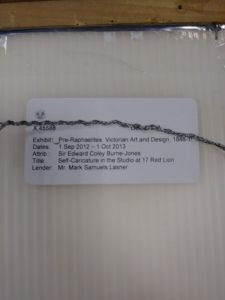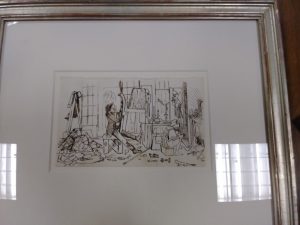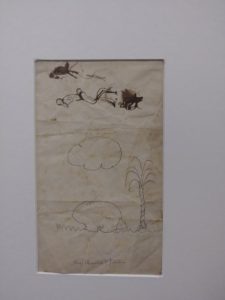The manuscript below is an art piece by Edward Burne-Jones, who was almost entirely an artist. This manuscript was the intellectual property of the Mark Samuels Lasner collection in the University of Delaware. Below are pictures of the manuscript.



Self-Caricature in the Studio at 17 Red Lion. Ink on paper, 1856.
The self-caricature is rather small in comparison to the frame it is held in and the piece was small in general. The ink color of the self-caricature was black. Edward Burne-Jones was quite fond of making sketches and given the size of this piece and detailing, this was likely one of his many sketches that he worked on in even greater detail. The picture below depicts a sketch of a wombat, seen in the Mark Samuels Lasner collection, and this is much more characteristic of a sketch by Edward Burne-Jones.

Sketches of Wombats. Ink on paper, early 1860s.
As the manuscript is in a frame behind glass, the texture of the paper was unable to be felt. However, the caricature was in much better apparent condition than the sketch, which had many wrinkles along it and the paper on which the sketch was on was discolored. The caricature had no visible wrinkles and the color of the paper had not changed drastically. The medium of the caricature is ink. This manuscript had quite some depth of effort put into it from the amount of detail. The caricature was likely either drawn over in ink or redone in possibly several sketches that came prior to it. The sketch of the wombat, in contrast, had ink but not nearly as much detail.
In terms of the content of the caricature, Edward Burne-Jones can be seen toward the center of the piece appreciating a high-back chair designed by William Morris. He is in the abode he shared with his roommate, Morris, who can also be seen in the caricature to the right of Burne-Jones. Morris appears to be focusing on his own work or contemplating new designs. To the left of Edward Burne-Jones can be seen a great mess of clothing and a chair caught in the mess. These clothes can be assumed to be either Burne-Jones’s or Morris’s or both of theirs. Beneath both Burne-Jones and his roommate’s feet, random objects scattered on the floor as well as what appears to be a lizard can be seen.
As this piece was a self-caricature of Edward Burne-Jones, it was quite a display of how he saw himself as well as how he saw the world around him, especially while he was focused on art of any sort he admired. While at first glance, it seems like Burne-Jones and his roommate were untidy tenants, this mess is likely not reality. This was Burne-Jones’s perception of what was around him. Either that or he was being realistic and there was a mess around them at all times. The caricature depicts how in Burne-Jones’s eyes, nothing else was as important as art in his days with Morris. Regardless of what kind of mess surrounded him, he was still fixated on art as well as likely contemplating future ideas for his own work. His work was his passion, the reason he left school, and his livelihood. In his eyes, he could afford to have a bit of a mess around him. The self-caricature was not so much a portrait as it was a cartoon. As is characteristic in cartoons, there is quite a bit of exaggeration in the details. A portrait also usually has a more close-up focus on the subject. It appears that Burne-Jones intended for his viewers to focus not only on him but also on his surroundings.
Since the caricature was made of Burne-Jones living with his roommate and not of Burne-Jones living with his wife Georgiana and their children, it can be determined that this caricature was made early in Burne-Jones’s career as an artist, before he got married.
Edward Burne-Jones was one of the later members of the Pre-Raphaelite Brotherhood. He was very much involved with William Morris, a very influential member of the Pre-Raphaelite Brotherhood, to the point that when William Morris died in 1896, he was affected by it as Burne-Jones died not too long after in 1898. The Pre-Raphaelites had an uncommon obsession with wombats to the extent that Dante Gabriel Rossetti had multiple wombats as pets. Burne-Jones made a sketch of a wombat, as can be seen. The self-caricature definitely seems to have been a detour from the style of the Pre-Raphaelites. While there is much attention to detail, it is not certain whether these details are accurate as it is a caricature. There are no heavenly qualities as can be seen in many of Burne-Jones’s other works. In addition, this caricature also has not been taken directly from nature as is the Pre-Raphaelite Brotherhood Method.
By being able to look at the manuscript of this piece first-hand, we are able to look better at the details of the piece as well as the condition of it which speaks volumes of its worth to those who owned it including Burne-Jones. He likely valued this piece highly as it was a memento of his struggles early in his life and career before he had attained fame and fortune as an artist and had a family of his own. Since it is a picture, looking at it first-hand allows us to further appreciate the effort Burne-Jones took to draw this piece. Minute mistakes that exemplify reality show us that these artists were not perfect. They were human just like the rest of us. When we look at pieces of art indirectly, it is much more difficult to find any mistakes in the work and while this is because the artist put great efforts into getting their work as perfect as possible, it is also because we are not able to pay so much attention to detail unless we observe the source material work.
Works Cited:
“The William Morris Society » Timeline.” The William Morris Society. Accessed May 18, 2018. https://williammorrissociety.org/about-william-morris/timeline/.
MacCarthy, Fiona. The Last Pre-Raphaelite: Edward Burne-Jones and the Victorian Imagination. Cambridge, MA: Harvard University Press, 2012.







